There are many truly great board games out there, but I’d be hard pressed to ever find one that I love more than Lords of Waterdeep. Introduced to Braden and I by Old Man Callahan, we then bought a board game version and an online version and began spreading the love for this truly amazing European-style board game that includes the use of intrigue cards, worker placement, and intense strategy to create a great playing experience.
That’s even before looking at the outstanding art on the cards, the excellent expansions, and how the random array of cards, lords, and buildings mean every game will play out differently. This makes for a fantastic combination that creates a game that really never loses its luster. There are few games that I’m up for playing nearly 100% of the time and Lords of Waterdeep is one of them.
This article isn’t a full review of Lords of Waterdeep. There are plenty of places to find those, as well as links at the end of the article to some of our favorite play-thrus of this game online.
This is THE most complete and in-depth Lords of Waterdeep strategy guide online on how to play well no matter who your Lord is. For for now, let’s dive into how to play your lord like a boss, regardless of which lord you get.
Note: If you enjoy this over 10,000 words of incredible content please consider purchasing this game and/or its expansions through our Amazon Link to help support the site. If you already own the game – buy it for a friend or family member who loves board games – never hurts to have more Lords in Waterdeep!

Your Complete Strategy Guide to Lords in Lords of Waterdeep
Some lords are just harder to play than others. Certain lords give you an advantage going into the game just as others put you at a disadvantage unless you get great starting quests or things play a very certain way. Pretending every lord is a Danilo Thann or Trobriand just wouldn’t be
Lord’s Power Grading Scale
So for my grading scale A level lords are always top notch/early favorites regardless of buildings, quests, or board. B level lords generally have excellent synergy and with a few breaks can jump to A-Tier in the right games. C-Tier is average, although these lords are all viable on most boards but need some help to hit next level dangerous. D-Tier are lords that require really friendly boards to become strong, and then you still have to compete on a board that helps out opponents. One lord is unplayable. That’s pretty self-explanatory.
A-Tier: Irusyl Eraneth, Danilo Thann, Trobriand
B-Tier: Sangalor*, Halastar Blackcloak*, Brianne Byndraeth, Khelben Arunsun the Blackstaff, Piergeiron Paladinson
C-Tier: Caladorn Cassalanter, Durnan the Wanderer, Larissa Neathanl (The Builder)*, Mirt the Moneylender, Sammereza Sulphontis, Kyriani Agrivar
D-Tier: Nymara Scheiron, Nindil Jalbuck
Unplayable: Xanathar
Lords denoted with a (*) are wildcards – their rankings can shift radically based on the board and game – even more so than the others.
This is my personal list, and it’s a topic that we’re passionate enough about that we even dedicated an episode of Unqualified Experts to the Best and Worst Lords of Waterdeep.
Note: We always play Lords of Waterdeep with the two expansions, because that takes a really great game and makes it just about perfect. These generally stay at about the same level if you don’t use the expansions, although some lords would move slightly in comparison to one another in that case.
Important note: there are certain plot quests you should always grab. Most of these aren’t mentioned in the strategy sections because it’s obvious you should want them in this game regardless of lord in most cases.
Here’s the strategy for how to play them all, but first, a house rule worth adding into your game:
Our Favorite House Rule(s)
This isn’t an official rule. In Lords of Waterdeep (including the expansions), you pick one lord card blindly. However, we didn’t originally know that since Old Man Callahan introduced the game to us with a house rule he plays that we’ve adopted.
- Instead of picking from one lord blindly, we give two to each player who then chooses the one they want before returning the other card (facedown) into the deck.
- We also choose to remove Xanathar from the deck.
This is a house rule, but it’s one we all really enjoy and would swear by.
Playing A-Tier Lords
These lords are generally going to be strong no matter what type of board pops up, but there are still ways to play them to make them even more effective. If you see one of these lords pop up in your hand, try to hide the smile because you’re in a good place.
What do these three A-Tier Lords in Lords of Waterdeep have in common?
- All three of these lords are easy to disguise because of their bonus conditions. You’re not tied to one or two types of quests, making it much harder to block your moves until it’s too late.
- The bonuses for all three lords are excellent. Irusyl Eraneth & Trobriand get more than the standard 4 points per bonus while Danilo Thann’s is smaller, but applies to every single completed quest, giving you points by volume.
- They allow you to change strategies on a dime based on the quests showing, buildings in play, or moves of your opponents
- They all allow flexible quest choices
Irusyl Eraneth

The only lord to make the top five of both Braden and I’s list on Unqualified Experts (link to that YouTube show episode HERE), Irusyl is a fantastic lord. First of all, the 6 point bonus for each completed quest is 50% more than the average bonus of 4 points per bonus quest. Second, you don’t need to make a choice right away.
Is the board a heavy Piety board with extra cleric buildings? Great, go ahead and start completing those.
Is it a really mixed board but you’re starting with two good warfare plot quests? Finish them and see how the board plays out. Feel free to clear quests off the top or horde different hard to get pieces like wizards and clerics early as you watch how the board plays out.
If everything seems a jumbled mess you can simply look for the best plot quests, the best high point low piece quests, and see how the board plays out. Mid to late game there might be one type of quest that shows up in abundance and nobody has a lord matching that type. Clean house.
Since you don’t have to choose which quest type is your bonus until the end, you may start out with one type of quest, see it dry up, and switch over to another that nobody wants and still end up with a huge bonus at the end.
No other lord allows that type of versatility. So how do you get even more out of Irusyl Eraneth?
First Step: Look at the quests
You want to look at the quests in your hand as well as those showing on the board. If you have two skullduggery or two warfare, and there are several of those quests on the board starting off, then you may want to take advantage of that right away. This is an early boost to your potential end of game bonus.
Don’t just look at the quests, but see if they are ones that are viable to do relatively quickly or within a reasonable time. Some quests take a ton of resources and it might be best to defer two or three of those to see what comes up next. But be aware of the quests that other players have, that you have, and that are on the board.
Second Step: Look at the buildings
There might be a lot of Piety or Arcane quests showing, but are there any buildings offering clerics, wizards, or “choose your piece type” of buildings out? If you’re considering commerce, there better be some serious money producing buildings out there. If Builder’s Hall shows powerful buildings like the kind that put out three wizards, three clerics, or the famed 4 + 2 rogue or warrior buildings, it can definitely be worth going after those types of quests even if there are none showing in the beginning.
This is because the board is going to be flooded with these types of pieces throughout the game so clearing the quest board to get quests that match up with buildings in play (or soon to be in play) can be a very powerful strategy.
Third Step: Where’s the “synergy?” What are the traps?
An obvious trap would be a board full of commerce quests – but no buildings offering money. Having a bunch of commerce quests can be great but if they all require 4-10 gold, you’re going to run out fast and that will kneecap your efforts. Wizards and clerics can easily become choke points for getting quests done.
Pay attention to what other players are doing with these traps. If one player is going for money non-stop chances are they have some commerce or skullduggery going on. If two players are fighting over clerics non-stop, pivot to a type of quest that will be easier for you to stack up.
Special Quests to Look Out For
- Diplomatic Mission to Suzail (Piety Plot Quest) that allows you to complete quests showing at Cliffwatch Inn
- Defend the Lanceboard Room (Skullduggery Quest) that is expensive, but allows you to pick eight pieces of your choice upon completion – a great way to load up on clerics/wizards on a scant board
- Any plot quest that gives you bonus points for completing quests of a certain type
Special Notes: If you have a good play for Piety quests, look for the multiple Piety quests that allow you to instantly grab another from the top. These are pretty good quests period, but they can snowball out of control for Eraneth, especially if clerics are available on the board.
Danilo Thann
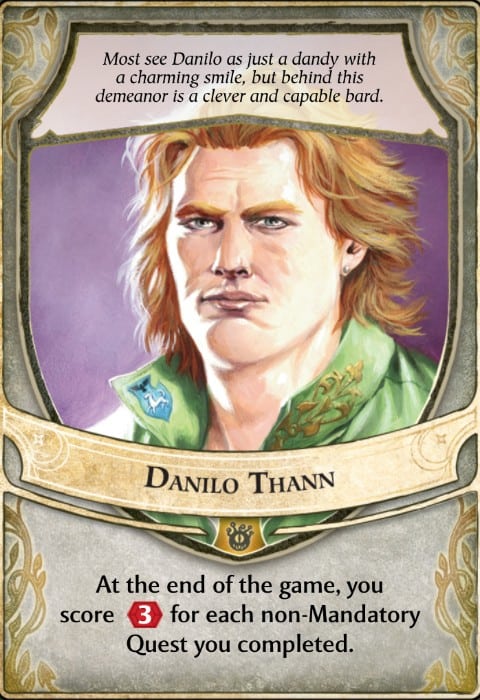
This is my personal favorite hidden lord in the game. Although any of these A-level lords are great, Danilo is particularly powerful for players who love completing lots and lots of quests. If you’re good at chaining together quests that reward you with more units to go from one quest to another, then Danilo will be outright deadly.
Danilo’s bonus means you can’t block the bonus. Every single completed quest (other than mandatory quests) gives 3 points. While this is less than the standard 4 point bonus, since it applies to all quests you should more than make up for it.
This also makes small quests requiring only three pieces much more valuable since you can really rack up the bonus points on them. In a long three player game, it’s possible to score 60 bonus points. Even in a three player game with both expansions, you should be well north of 30, likely in the 40+ area.
That’s a hard bonus to overcome, not to mention all the points you pick up along the way from doing the quests themselves.
There are two things you want to focus on with Danilo: getting enough quests and stockpiling resources.
When you don’t have a clear play, finding the spot that gives you the most money or extra pieces, even if you don’t need them immediately, is almost always the best play. With the sheer number of quests you’ll be picking up and completing you want to get the most value from every single one of your meeples that you can.
That means looking for intrigue cards that give you resources and let you play on the harbor to re-play that meeple at the end of the round, grabbing those 3-4 piece spaces when they’re open, and taking a LOT of quests.
You really want to look for quests that reward you with more resources so you can finish one quest and be right on the way to completing another. Below are just three of the many examples of quests that allow you to do this in the game.

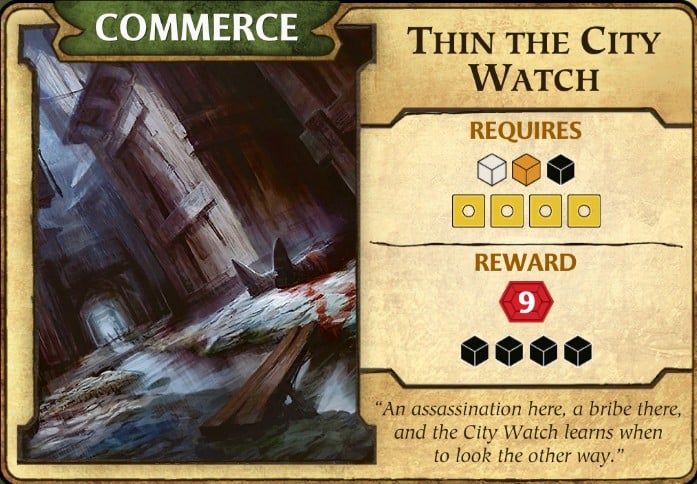

Also don’t be afraid to use your bonus as a weapon by clearing a stacked deck of quests at Cliffwatch Inn. If you’re going first and all four quests showing are high point, high value quests that take a lot of pieces, you may decide to wipe the board to keep those big quests from your opponents and grab smaller, easier to finish ones that can then catapult you into finishing even more quests for more bonuses.
You will grab a lot of random small piece quests with Danilo, and that’s a great strategy to just keep stacking up those bonuses. Chain the quests, grab those “always powerful” plot quests and quests, and as long as you focus on hoarding resources you will be a powerhouse by game’s end.
Special Quests to Look Out For
- Seize Citadel of the Bloody Hand (Warfare Plot Quest) one of the best plot quests of the game, but if you can get it early it’s especially devastating with Danilo since you get one piece back from every single completed quest. That can stretch a single cleric or wizard a very long way.
- Diplomatic Mission to Suzail (Piety Plot Quest) that allows you to complete quests showing at Cliffwatch Inn
- Any quests that reward you with more quests, money, or pieces – like those “chain quests” in the small gallery above
Any Special Notes
Be wary of gold-starved boards. While there are plenty of quests that don’t require gold, most do. 2-4 gold pieces a quest adds up if you’re shooting for getting 15-20 quests done in a game. Make sure to leap on those quests that don’t require gold if you don’t see any buildings giving more gold popping up during game.
Trobriand
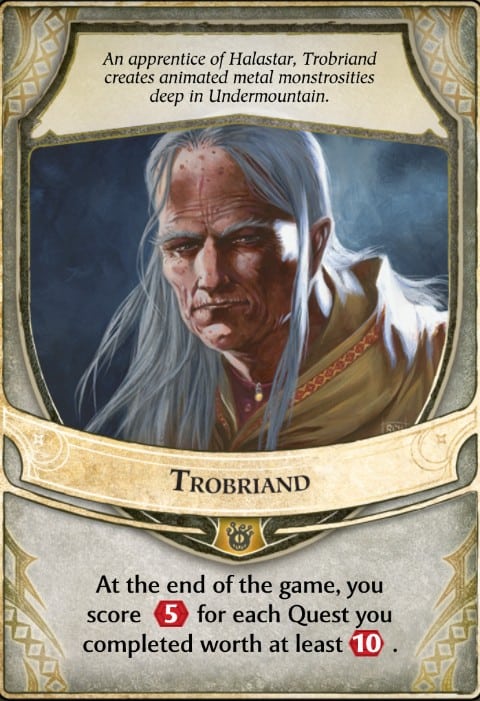
The favorite lord of seemingly everyone else in our group, Trobriand allows you to focus on high paying 10+ point quests and receive better than average end of game bonuses for them on top of it. This lord works well not only because you can grab higher scoring quests of any type and get a bonus, but the focus on 10+ point quests means you’ll have a pretty powerful score going into scoring at the end of the game.
Admittedly, Braden and Callahan are better at playing Trobriand than I am. While I’m okay with it, I’m more of the burn and churn quest method, which makes them utterly loathe Danilo – in part because I don’t think I’ve ever lost with him.
However, Trobriand is undeniably powerful and I hit up my two fellow Meeples for some of their advice on how to get to the next level with this unique and powerful masked lord of Waterdeep.
One thing to keep an eye out for in the first two rounds are really good plot quests. You will need a lot of resources to tackle the larger demands that most higher point quests will require. Because of that any plot quest that lets you re-claim used meeples, collect extra pieces, or collect extra gold should be high priority.
The next important step is to realize that not all 10 point quests are equal. Piety quests above ten points tend to take far fewer resources, but require clerics and sometimes wizards – premium pieces.
However, if those pieces are readily available these become easy points for you. Commerce quests tend to also offer some great high point quests for a low amount of pieces, but with a lot of gold involved. On a board flush with gold these are great options. If that’s not the case, you’re better off going for other quests.
Consider a high corruption game. Many of the best spaces on the board for getting sheer amounts of pieces come with a corruption penalty. However many of the quests that get rid of corruption are exactly 10 points. This can make for a great strategy if you get enough of the return corruption quests in your hand.
That opens up spaces that give you more money and more pieces, or taking advantage of the plot quests that allow you to double the pieces you get from buildings on the base board like the Grinning Lion Tavern or Field of Triumph. Those extra pieces mean more completed high point quests and the ability to finish 10+ point quests that then return that corruption to the table.
In many ways playing Trobriand effectively is like playing Danilo Thann. You want to cycle through as many quests as possible – but the floor is 10 points instead of “just anything.” This does require more planning.
Special Quests to Look Out For
- Plot quests that allow you to gather extra pieces (even at the price of extra corruption)
- The Lieutenant (Warfare Plot Quest) ONLY if in the first three rounds, but that extra meeple is huge when getting more resources for completing quests, especially if you end up with a lot of intrigue cards to play at Waterdeep Harbor
- Defend the Lance Boardroom (Skullduggery Quest) not only allows you to pick 8 pieces of your choice after completion (hello clerics and wizards!) to complete other quests, but it’s 12 points so it counts as a bonus for you, as well
Any Special Notes
While that 10 point mark is important, don’t miss out on powerful plot quests because they are 6, 7, or 8 points. Some plot quests are very powerful and it’s worth taking the time to get these benefits even if it’s not a direct bonus at the end of game.
Playing Wildcard Lords
These lords are some of the most fun to play, in my opinion, because you just don’t know how they are going to play out. Two I would have ranked as B-lords without seeing the board. Those are the ones that come with the expansions: Sangalor and Halastar Blackcloak. Then there’s Larissa Neathanl whom everyone who has played the game knows simply as: “The Builder.”
Generally speaking these lords all have the potential to be very powerful, but they each have flaws that can turn them the other direction, as well. This makes them very interesting for different reasons and among the hardest to predict how they’re going to play. When the board goes well, these lords can all jump to A-list. They can also make your game go bad fast.
Larissa Neathanl aka The Builder

The Builder is such an interesting lord. If you are the builder, it’s going to be impossible to hide for long without sabotaging your own bonus. That makes it easy to target a bullseye on you. This also makes it easier for other players to block what you’re doing, or at least make you waste time using meeples on The Ambassador if it’s in play or Castle Waterdeep to make sure you’re in position to get to Builder’s Hall.
The 6 point bonus versus the standard 4 means there’s plenty of potential for racking up the points, and with plenty of gold and help from a few quests you can turn The Builder into a powerhouse.
However, without any special plot quests, or building award quests, the builder is actually very blockable by experienced players.
Playing the Builder
The goal is simple. You want to build as many buildings as possible. Hiding this is going to be impossible so your goal is to make it as hard to stop you by the time the table catches on as possible.
Play the Intrigue Card Game
The Builder absolutely needs to play the Intrigue Card game. There are several reasons for this. For one, there are three cards that allow you to build a building from a different spot, take over an opponent’s building, or even destroy an opponent’s building to replace it with one of your own. Pro tip: when doing that last one take the opportunity to destroy a low gold value building so you only pay a small amount to another player, but then grab the most expensive building from Builder’s Hall. Built in discount!
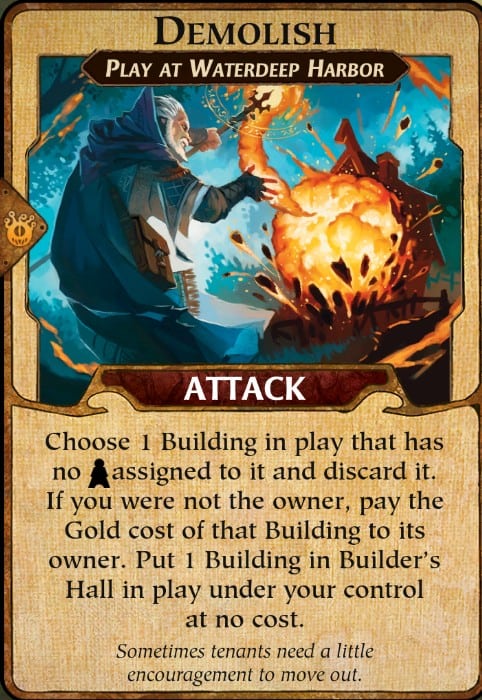
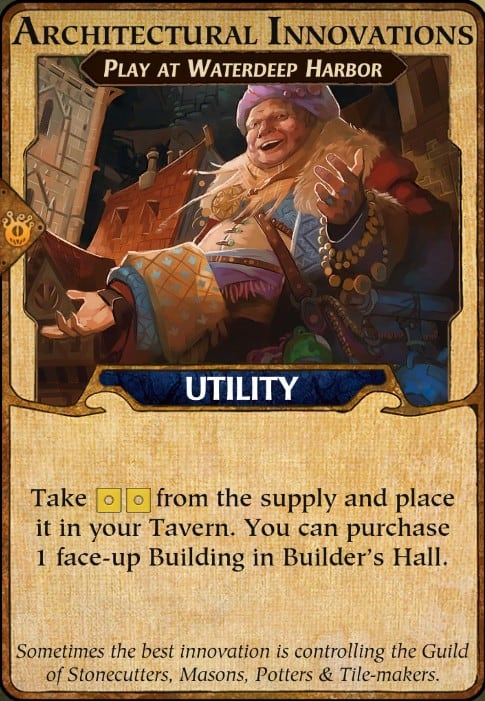

Even in addition to these really useful cards, you will want to search for Open Lord to protect yourself from the two of these cards that are attack cards. Many intrigue cards give you gold, which is an absolutely crucial resource for The Builder, for obvious reasons. Add in cards that let you use the same space as another player who has more corruption than you, or for a simple fee of two gold, and that is an easy way to get around a potential blocking action at Builder’s Hall.
Grab Quests That Award Buildings
There are four quests that reward you with one or multiple buildings. These are great because you get points, free buildings you don’t have to spend gold on, and this can’t be blocked the way Builder’s Hall can be. If you somehow manage to get and finish all of these, that’s also 7 additional buildings (42 bonus points). That’s more than many lords will score for their entire bonus.
Don’t forget that if you are getting a free building, that’s a great time to pick buildings that are more expensive to save your gold, or to grab less useful buildings that have had points stack up on them throughout the game.
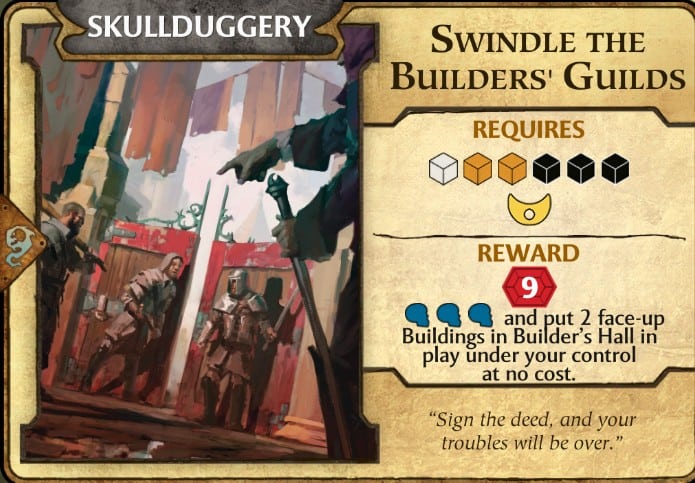
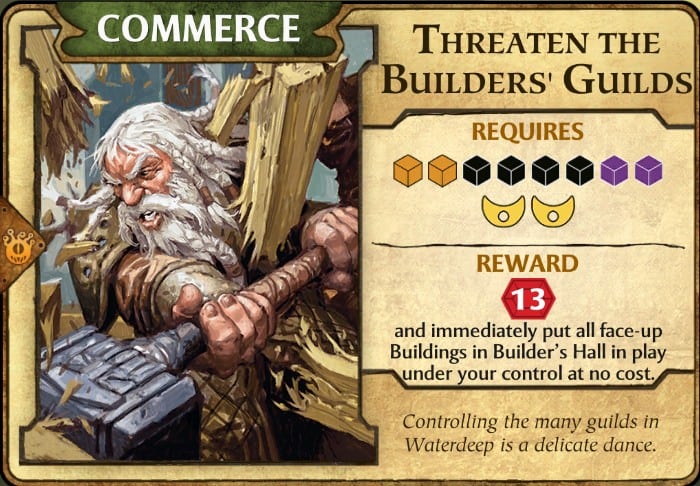
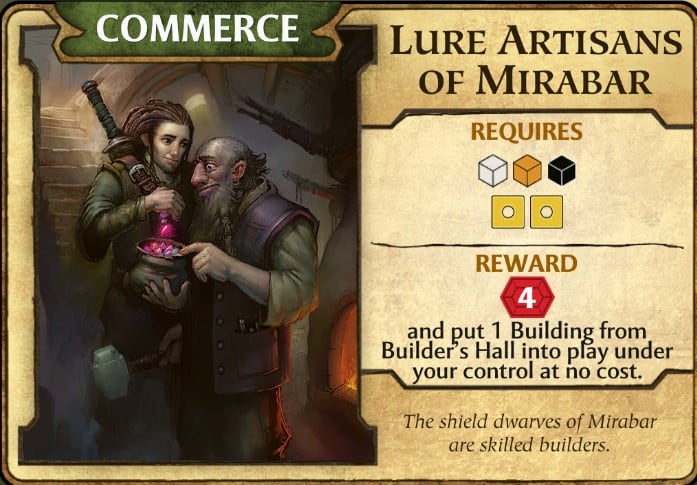
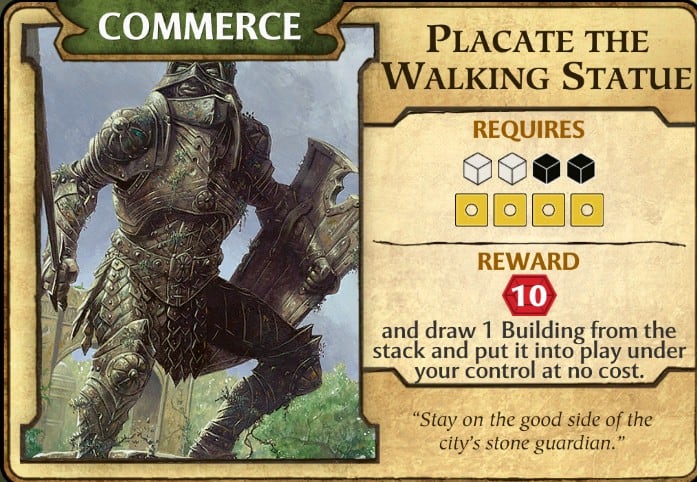
Which Buildings Are Most/Least Valuable for Opponents
You will need to make a decision at some point about which buildings you’re going to build. If you build all the most useful ones, the problem is you are giving your opponents the resources they need to finish quests and beat you. However, if you only aim for low value buildings that means other players are much more likely to jump in to buy the building they want, and then they end up with the bonus for people using that building, as well.
Hitting that balance is important. If you can get buildings that do other things like take away corruption instead of giving out free pieces, even better. Especially when you get points every time those buildings are used. Become a free point generating machine!
Your #1 Quest Priority
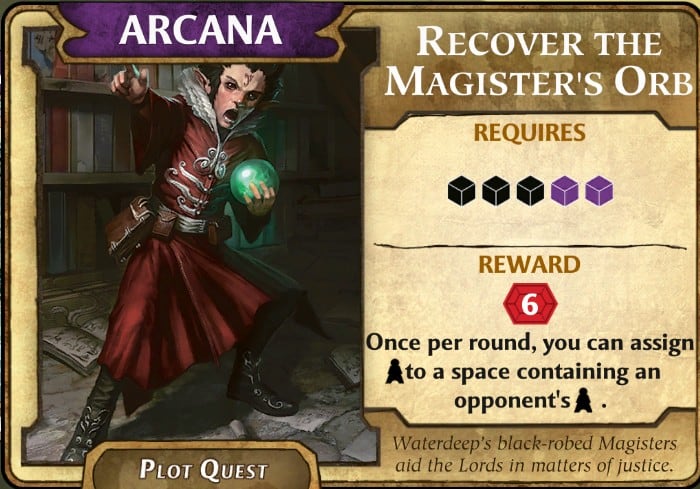
There’s a plot quest that you should look at as your top priority. It’s one of the strongest plot quests in the game (arguably the strongest) and a must-have if it’s available to the builder. That’s an Arcana Plot Quest called “Recover the Magister’s Orb.”
This is perfect for the builder because it allows you to use ANY space that another player is on once per round.
Since this isn’t an attack card from the Intrigue Cards, Open Lord doesn’t stop this. This one plot quest makes it impossible to block you from Builder’s Hall. That is a game changer if you’re playing the builder.
That’s even before considering this lets you commit to other spaces to complete quests or gather resources since all your focus doesn’t have to be on getting to Builder’s Hall first to build again.
Being able to avoid being blocked out of Builder’s Hall makes this a must-grab if it appears for the builder. This takes it from a C-Level wildcard lord up to a high B level, or even A-level with a few of the right quests or intrigue cards showing up.
The Importance of Position
Since you need access to Builder’s Hall not only to score points but also to avoid getting blocked out by other players, going first is incredibly important. The “Recover the Magister’s Orb” Plot Quest changes this. However, without that in play the Builder needs to focus on going first to make sure they always have first access to Builder’s Hall.
Don’t give up that top position.
The Wild Card Building
I’ve seen one person use this to really great effect. This building was out in round one, and that player used this as one of his main ways of getting points outside of buildings. That would be the Hall of Three Lords, pictured below.
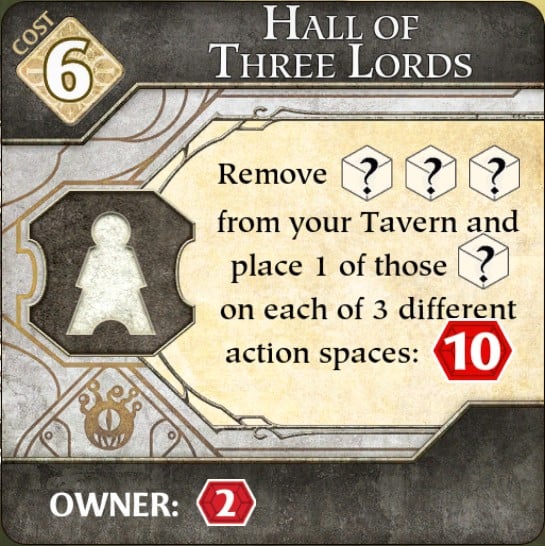
How many quests give you 10 points for only 3 pieces? Not too many. This also let the player only focus on low piece high point quests, those that gave buildings as a reward, and otherwise he could avoid corruption while grabbing some warriors or rogues and using those cheaper pieces to get another 10 points a round.
One piece would even go back on this building, one would go to Builder’s Hall, and one would go elsewhere. This meant the player recycled a lot of their pieces back to them, which gave them the late game pieces to complete some solid point quests, as well.
This is a bit of a high risk wild card strategy, but it can be surprisingly effective.
Special Quests to Look Out For
- Recover the Magiser’s Orb (Arcana Plot Quest) is one of the strongest plot quests in the game, but it’s absolutely essential for The Builder since this makes it impossible to block you from Builder’s Hall
- Any Commerce or Skullduggery Quest that gives a free building (or buildings)
- Establish Safe House for the Harpers (Skullduggery Plot Quest) – 2 points for every building you own when you complete the quest!
- Infiltrate Builder’s Hall (Commercial Plot Quest) – 4 bonus points for every building you build.
Any Special Notes
Don’t underestimate completing quests! This is a powerful strategy and you get to be picky about which quests you take based on points versus requirements. You can avoid quests asking for pieces that are scarce on the board while also blocking other players from the quests that they want.
Sangalor
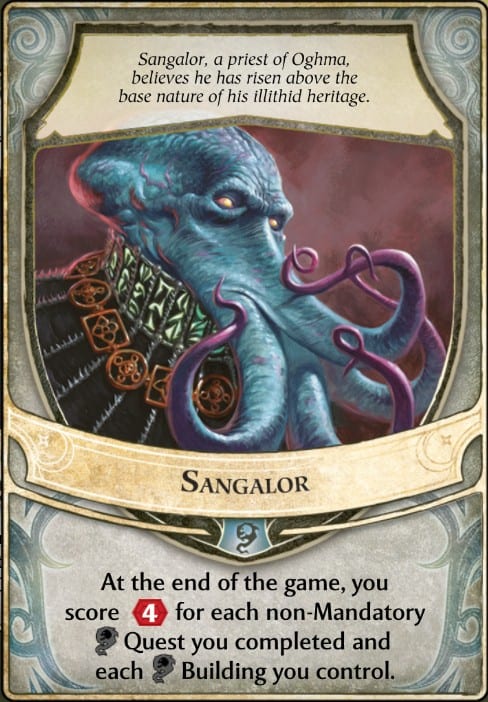
Sangalor and Halastar are two of the big stars of the expansion packs to the original base Lords of Waterdeep game, and they are definitely wildcard lords just because of how bonus scoring works for each of them. For these lords they score based on a combination of buildings built and quests completed.
With Sangalor it’s the Illithid symbol. These appear on all the quests and buildings that come with the expansion. You add together the number of quests with this symbol with the number of buildings you control and that times four is the bonus. This makes it easy to hide who your lord is early on.
Especially since many of the better buildings and quests in the game have this symbol on them. Especially for high corruption games since virtually all the cards that take away corruption will have this symbol on them. There have been many games that went to the last couple rounds before anyone figures out someone might be playing Sangalor.
Potential to be overpowered? Absolutely, but that rarely happens.
Why? Because other players are going to eye building Sangalor’s buildings (that’s true even if no one is playing The Builder).
High corruption players, which a lot of advanced LOW players are, will also need those return corruption quests to avoid getting hammered. That means many of these quests will be snatched up by others even before considering each of this quests has types (Piety, Commerce, etc) that other players will be going after.
This combination is what keeps Sangalor in line. You have the potential to be very sneaky with what you do, and very free in the plot quests you chase, but it’s going to be unlikely that you just stack up an overwhelming bonus. Still, play him right and Sangalor is a very powerful lord.
Use Your Freedom
Generally speaking most players aren’t going to figure out which lord you have. Even when suspicious, you’ll usually a hear “Might be Sangalor or Halastar,” and then they go on with the game. Blocking these lords is more difficult so most players don’t bother even bother trying most of the time.
Use that freedom to go after the highest value play on the board. You can pay attention to the types of quests others are looking for, grab the top buildings or plot quests, and keep the bonus as a side pursuit. That gives you a freedom of movement that not many lords have whether planning ahead to grab an available quest, grab resources for a nearly plot quest, or picking up a cheap building that has that special little mark you’re paying attention to.
This lord allows you to be more pro-active and adjustable than many other lords in the deck. Take advantage of that freedom for your in-game strategy.
Play a High Corruption Game
You have buildings that get rid of corruption and give you a good bonus when someone else uses it. You have quests that get rid of corruption that also give you bonus points. Take advantage of those cards or spaces that give you extra resources for corruption. This allows you to get more quests done while you can take care of corruption.
While this can be a risky strategy if you get caught with corruption, since you’re particularly focusing on buildings and quests that help you shed corruption you should be able to pull it off. This means the ability to take advantage of spots that give you more or specialized units at once, complete more quests, and pick up some nice bonuses along the way.
Misdirection or Burn & Churn?
If there are multiple bonus quests that are all one type like warfare, don’t be afraid to grab those and a couple more decent warfare quests to throw other players off the scent. There’s so much to keep track of that even good players rarely re-examine their assumption about which lord you have.
If that keeps people blocking a type of quest you don’t need in the future, keeping your actual bonus quests or buildings open, all the better!
Don’t be afraid to grab non-bonus quests along the way, or good buildings that offer other bonuses. If you start with 3 buildings that give you your bonus, going heavy with the early building can make other players keep buying buildings if they think they’re blocking The Builder. Meanwhile you have an excuse to churn through the quests because if they think you’re a builder, you don’t necessarily have a rhyme or reason when it comes to what quests you want to complete.
Special Quests to Look Out For
- Piety quests that allow you to grab another quest – this can be a sneaky way to look like a Piety lord while grabbing some of your actual bonus quests
- Quests with money as a reward – many of these quests have some gold requirement and those can add up quickly
- Quests that award you buildings
Any Special Notes
Sangalor is a lord where playing him really well means noticing the details of each individual game. Because of the unique scoring mechanic and the fact that there isn’t just one or two “types” of quests, the demands for gold and types of pieces can be high. These are lords that will be better and better as picks the more you play the game and learn its intricacies.
Halastar Blackcloak
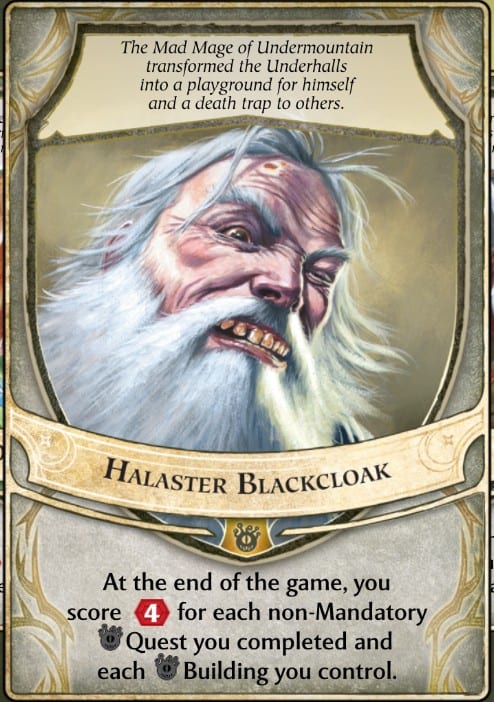
Halastar is going to play very similar in fashion to Sangalor. The biggest challenge you’re going to face with this lord is that virtually every other player at the table will want the buildings and quests that give bonus points for this lord.
Every 40 point quest in the expansions is a Blackcloak bonus, as is Defend the Yawning Portal (one of the most powerful quests in the game), and many of the more popular plot quests. Many of the most heavy duty buildings everyone wants in the game are also often carrying the Blackcloak mark.
The good news is that this makes it incredibly easy to hide which lord you are. The bad news is getting a good number of your buildings and quests is going to be a chore. There will be a lot of competition and many of the ones you get require a lot of resources.
This dictates how you have to play Halaster.
Build Those Resources
This can mean dedicating meeples to the Slaver’s Market to get those extra rogues and warriors. This means you’re looking for plot quests that give pieces back or regular quests that award you with more pieces. This could mean building a non-bonus building that gets you pieces or gold. You’re going to need a lot of resources to rack up a healthy bonus with this particular lord.
Bonus May Not Matter as Much
Because so many of Halaster’s quests are high points, you don’t need as high a bonus to potentially win. If you do a couple 40 point quests and Defend the Yawning Portal, you’re already competitive to win a 4 player game. Halaster isn’t generally a lord you build a 40 or 60 point bonus with for the win, but when you see an inexpensive building or quest with that mark, grab it.
Even small bonus boosts for this lord can be devastating, especially if you complete some of the really high point quests. Since you’re not tied to one specific type of quest, you can adjust what you’re going after based on what resources are easily available on the game board.
Should You Play Corruption?
While the high corruption game can work, you do need to be careful and make sure you have the intrigue cards, corruption returning quests, or building options to get rid of it. Keep in mind that quests returning corruption often require a good number of resources, as well, and you don’t want to see your bonus disappear to a corruption penalty because you were caught flat footed at the end.
However, sometimes the best way to get a large number of the pieces you need is to use those corruption spaces. Generally if you have multiple intrigue cards to take away corruption, you can play a little bit looser than you otherwise would.
Special Quests to Look Out For
- Piety quests that allow you to grab another quest
- Quests that award pieces – many Halastar quests require a lot of pieces and resources
- Quests that award you buildings
Any Special Notes
Halastar, much like Sangalor, is another lord where the details of each game matters. One of the major challenges that will consistently come up with Halastar is the fact that many of his buildings and quests are some of the most powerful in the game. Be aggressive with this lord, grab the buildings and quests you want, and if not a lot is showing play the intrigue card game and get the quests that give you the best point return for your efforts.
Playing B-Tier Lords
These are lords who aren’t top tier, but they are definitely a step above the mid-range lords. These tend to have two types of quests that go well together, or play in a way that makes them more likely to have a high power game versus struggling. Any of these lords is likely to provide you with plenty of options in the upcoming game and it will take a really unlikely bad board and bad luck to be locked out of contention.
Brianne Byndraeth
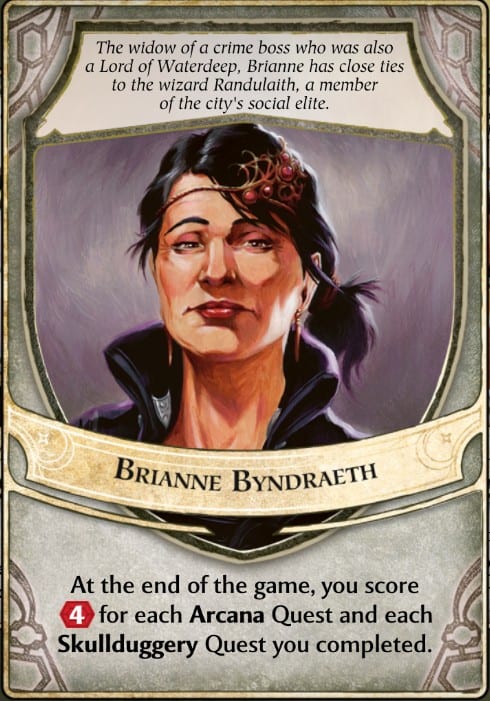
Arcana and skullduggery are two types of quests that go hand in hand very well. Arcana tends to require many wizards, a good number of rogues, and then occasional warriors and clerics. Skullduggery requires many rogues, some wizards, and occasional warriors.
Both of these had mid-level money demands which can cause a gold squeeze, but this can usually be worked around especially with the number of quests giving gold and intrigue cards as awards.
That ability to focus mostly on just two piece types and some occasional gold makes Brianne a very powerful lord, especially if you pick up many of the Arcana quests that give gold, cards, and clerics or warriors to make up for other needs.
Taking her from a B-Tier lord to a dangerous A-Tier does take some careful strategy.
Wizards, Intrigue Cards, Cash – Usually in That Order
Once in a while you might have to adjust based on in-game conditions but generally speaking the best way to play this lord is to look for ways to put more wizards on the board, create a steady pipeline of intrigue cards so you can make use of the Harbor, and making sure it’s not a gold poor board.
The Piety Plot Quest Defend the Tower of Luck is great if you get it early. Since that then provides a free piece at the beginning of each round – a wizard pipeline! Getting Explore Ahghairon’s Tower early is also huge. You’ll be grabbing lots of wizards anyway – getting free intrigue cards with them takes care of 2/3 things you need.
Most of the plot quests allowing you to double the pieces from board spots for a corruption are usually overrated. Generally, there are enough warriors and rogues that you really don’t need to grab corruption for more. Especially with the expansions in play. However, the Recruit Arcane College Castoffs allowing you to get two wizards and a corruption instead of just one wizard is definitely worth picking up. It’s low cost, it’s a bonus point quest, AND it’s very powerful on a wizard starved board.
If you start with Study in the Librarium that’s a tricky plot quest. It is devastatingly powerful, but very expensive meaning you may be throwing away two rounds of actions to get it. If you can do this in the first few rounds, it is almost always worth it. Spam Skull Island, Blackstaff Tower, and Hall of Mirrors early. If you have this active by round 3 or 4 you can normally wreck the table.
If you don’t see this quest until round five or later, unless there are a lot of buildings giving 2-3 wizards a pop or you have a giant stockpile, it’s usually worth skipping to complete other Arcana quests. The one exception might be if you can finish it quick, have double digit intrigue cards, and multiple buildings with open play intrigue card slots, as well.
Play the Intrigue Card Game
Arcana is especially built to give you many intrigue cards. These come as rewards from multiple quests, and then there’s the Study in the Librarium plot quest that allows you to draw and play an additional intrigue card every single time you play an intrigue card. It’s arguably the most expensive plot quest but if you are lucky enough to get this early, it’s often game over for other players.
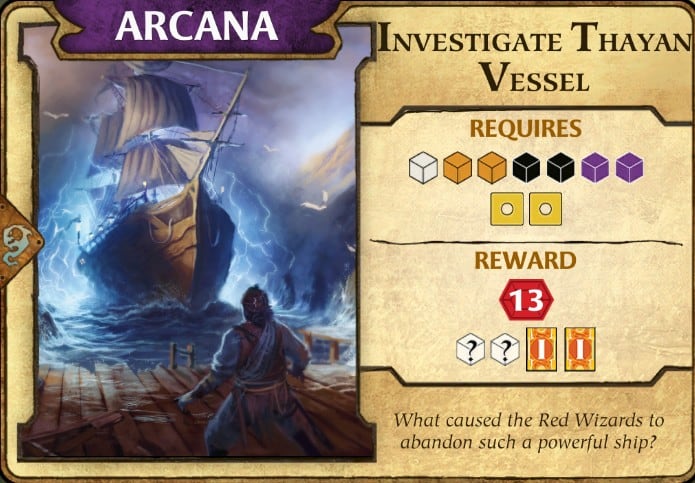
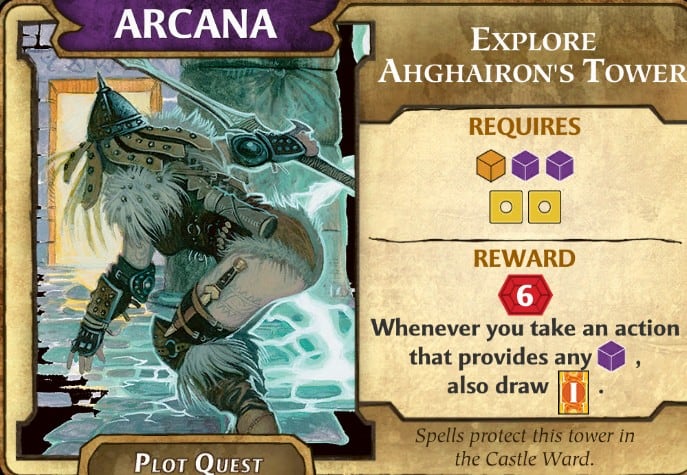
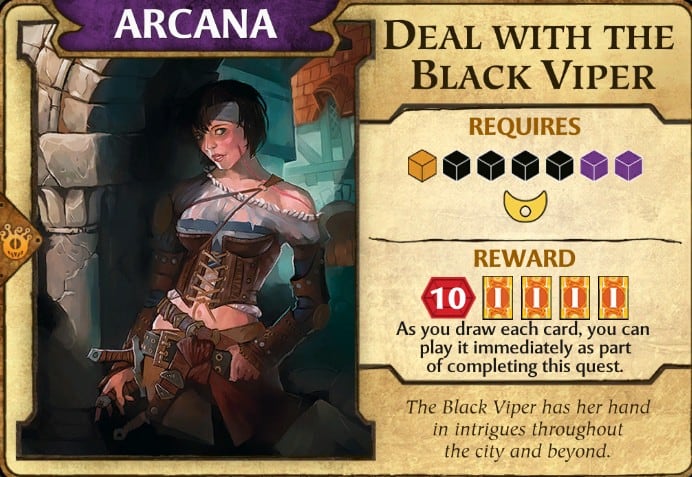
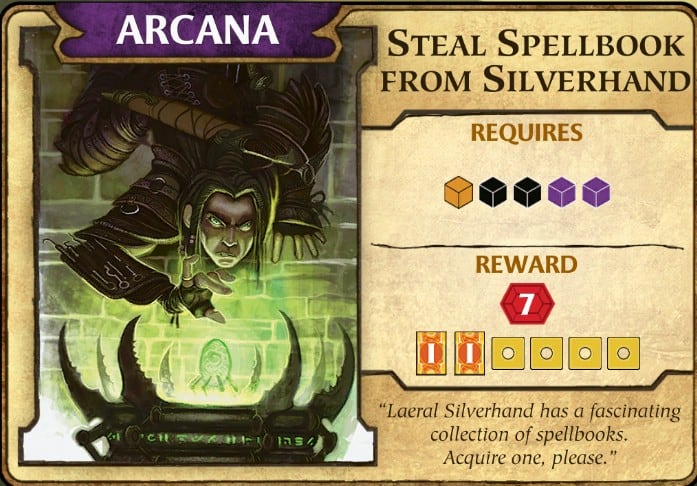
An overly strong intrigue game allows you to gather pieces and money while using harbor spaces, allowing you to get even more turns to keep gathering even more money and pieces at the end of each round. This can be an incredibly powerful cycle.
Special Quests to Look Out For
- Defend the Lance Board Room (Skullduggery Quest) can provide a lot of wizards all at once, as well as a couple of the occasionally needed clerics
- The Bribe the Shipwright/Fence Goods for the Dark Lord Plot Quests – both if you can pull it off
- Recover the Magister’s Orb – you need to always have access to those few spaces that give wizards and this Arcana plot quest does it
- If you can get and complete it in round one or two: Defend the Tower of Luck (Piety Plot Quest) because a free wizard every round moves this lord up close to A-Tier
Any Special Notes
This is a strong versatile lord, and while you are looking for certain quests to pop up to sort of super charge her efforts, a regular game with a little bad luck still won’t necessarily bury this lord. Get a strong intrigue game going, find a steady stream of wizards, chain together quests that give you helpful rewards and you’re likely to play an incredibly powerful game. Even against the top tier lords in the game.
Khelben Arunsun the Blackstaff
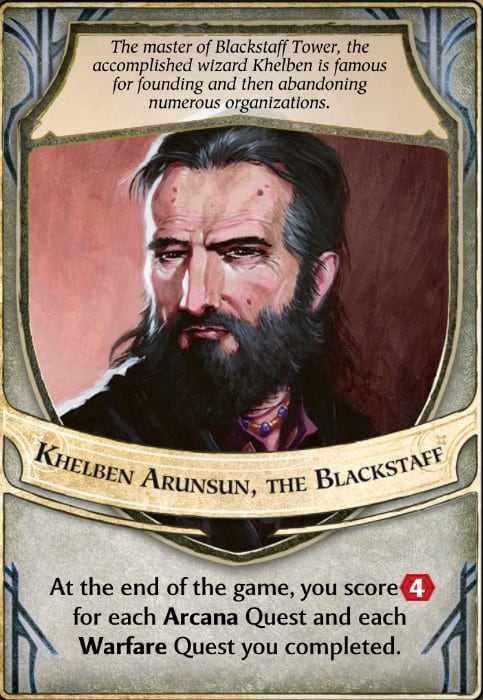
Also known as lord of the battle mages, Khelben Arunsun is a very solid lord whose bonuses of Arcana and Warfare don’t necessarily integrate as well as some other classes, yet they do just enough to make him a very solid choice. There are multiple reasons for this, and if you can get the right plot quest or two early on you can really turbo charge this lord’s ability to rack up quest completions, and bonus points with them.
At first glance you wouldn’t think these work well together, but they do a surprisingly good job. In part because the plot quests of each can be very powerful in helping out. Warfare generally requires warriors and then an equal measure of clerics/wizards. Arcana is mostly wizards and rogues, but with the occasional single cleric or warrior needed.
On the plus side, Warfare tends to have low gold demands while Arcana only has moderate gold demands. This is a definite plus as there are many playthroughs that end up being gold poor or forces corruption to get gold. With this lord you can generally avoid those nasty choke points.
Exceptional Plot Quests
There are several stunningly good plot quests in both Warfare and Arcana. Bolster Griffon Cavalry gives you an extra warrior every time an action gives you a warrior (this not only applies to any space that gives you a warrior, but also any space where you play an intrigue card that gives you a soldier as a result), Fix the Champion’s Games allows you to get 4 warriors instead of 2 as long as you take a corruption at Field of Triumph, Recover the Magiser’s Orb allows you to use any space that has already been used, while Explore Ahghairon’s Tower gives you a free intrigue card every single time you pick up a wizard, which you need to do anyway.
This doesn’t even mention that several of the most powerful plot quests in the game (Bloody Citadel, Lieutenant) are also warfare plot quests.
Take a look at early plot quests, and find that combination that lets you really optimize the board for your success.
Take Advantage of the Slaver’s Market Space
This is a very good space, period, but it can be especially good for this lord. Not only do you have that access to more warriors that you need, but this give you rogues that will be necessary for Arcana quests. Normally it’s worth taking multiple corruption to hit this a few times. Especially if you have Bolster Griffon Cavalry or Fence Goods for the Dark Lord plot quests completed.
Don’t Be Afraid to Lean Heavily in One Direction
While a combination of Arcana and Warfare quests can be devastating to other players, both are strong enough that you shouldn’t be afraid to go heavy one way or another. If you have the Bloody Citadel and multiple other buildings flooding the board with warriors, then go heavy Warfare and just pick up the extra Arcana quests when you can. On the other hand if you have heavy wizard or “choose your own piece” buildings, then go heavily with Arcana quests, grabbing the occasional warfare quest when it comes up.
This is incredibly hard to do in most cases with Commerce, Skullduggery, and to a lesser extent, Piety. Warfare this is easy to do and Arcana has many quests that are low investment/high reward (more so than Piety) and allow you to daisy chain quests or get resources to grab other random quests for more points. Either way, this makes Warfare/Arcana an impressive combination because they can pair up or with the right board you can solo in either direction.
Pick Your Plot Quests & Go
Depending on what shows up, and how early, it’s very possible to see four, five, or even six plot quests pop up that you want. This is too many. In these situations, it’s important to look at what you have in hand, which plot quests give the best return for the least investment, and even what buildings are showing in Builder’s Hall and if they all lean in a certain direction.
Pick 2-3 plot quests, and then run with it. You want to optimize and go, not getting bogged down.
Two exceptions: Seize the Citadel of the Bloody Hand & Recover the Magiser’s Orb are almost always a good grab all the way up through round six. The ability to get high value pieces back or jump on a space being “blocked off” by another player in those late rounds can be the difference between victory and defeat.
Especially since these both give bonus points to this lord.
Special Quests to Look Out For
- Bolster Griffon Cavalry – underrated Warfare Plot Quest that will provide many free warriors throughout the game
- Defend the Lance Boardroom Skullduggery quest requires a lot of gold and rogues, but if you have the resources this quest is a great way to load up on clerics and wizards to hammer out the quests
- Bribe the Shipwrights (Commerce Plot Quest) will help solve any rogue needs every time you grab gold
Any Special Notes
The Hell Hound’s Muzzle and Shardin’s Excellent Zombies are great buildings for your lord, and don’t sleep on House of Good Spirits – a very cheap building you can use to build your warriors while also grabbing a random wizard, cleric, or even occasional rogue.
Piergeiron Paladinson
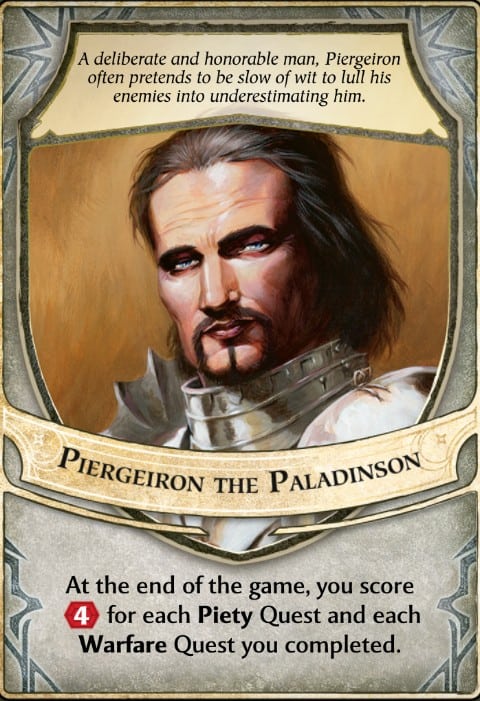
Personally among the B-Tier lords Piergeiron is my favorite even including the wildcard lords I would start in the B-Tier category. I feel like Piety quests and Warfare quests have the best synergy of any two quest types, the money demand isn’t over the top, and there are excellent plot quests, intrigue cards, and buildings that make these quests easier to complete.
Piety quests generally require a lot of clerics, a decent amount of warriors, the occasional wizard, and very few rogues. Warfare quests generally require a lot of warriors, some clerics, some wizards, and the occasional rogue.
This makes it easy to focus on just one or two types of units for most of the quests. Many of the best plot quests are all warriors, all clerics, or a mix of the two. Many larger quests only require a wizard and a rogue extra, with the rest being clerics and warriors.
This provides a very good opportunity to streamline recruitment and be able to churn out more quests since you need to spend less time gathering different types of units.
So what keeps him from being A-Tier? The very real chance that if neither of three plot quests show up or no good buildings, there will be a choke point on clerics. Any other lord looking at Piety quests and any player going heavily on warfare will need clerics. This can easily create a scramble for very limited spaces.
Create that Cleric Pipeline
Many Arcana quests require one or two wizards. Many Piety quests require three clerics. This means you need to build that pipeline to make sure you’re not the one running out. When it comes to creating this safety net there are a few things to look for. The first is any of these three plot quests, which should be finished as quickly as possible (take the corruption from Skull Island to get these done sooner if need be).



All of those give you the ability to produce many more clerics. The next step is looking at buildings that offer “pick your own pieces” options or the Room of Wisdom, which can flood the board with clerics. There’s also Secret Shrine which allows you to get rid of corruption and grab a cleric if you use it, or get a cleric when someone else uses it.
The combination of these can be devastatingly effective.
The House of Good Spirits only costs three gold and is a great way to provide warriors and potential clerics for you.
Grab Good Quests Early
While you don’t want to interrupt the building of your cleric pipeline, this lord more than any other getting a bunch of quality quests in your hand early so you can fully focus on resource gathering is a great strategy. Then you can be very picky about using those spots later while making sure to get those crucial pieces to keep those quest completions coming.
The Piety quests that award you by allowing you to grab another quest showing in Cliffwatch Inn can be powerful, but be sure to wait to complete them until there is a specific Warfare, Piety, or Plot Quest up in Cliffwatch Inn that you want to grab. If you have one or more of these, waiting to complete them until powerful quests are showing at the top can be a powerful strategy – not to mention a “free quest” you don’t need to use a meeple to acquire.
Go Warfare First if No One Else Is
This is a rare setup, but in a three or four person game if it seems like there are great buildings flooding the board with warriors, good plot quests are showing up for Warfare, and you have the 40 point Warfare quest, Defend the Yawning Portal, or both, then run with it. Taking care of these while taking advantage of any cleric producing quests/buildings that show up later can be very effective in this situation.
This can also cut the wind out of the sails for anyone who is trying to compete with you for Warfare early on.
Special Quests to Look Out For
- Diplomatic Mission to Suzail (Piety Plot Quest) allows fewer meeples to be used on grabbing quests and more on grabbing units
- Bolster Griffon Calvary (Warfare Plot Quest) is devastating with this lord as those extra warriors do serious work
- Commerce Quests that award buildings
- Piety Quests allowing you to draw another quest
Any Special Notes
Warfare has many obviously overpowered and high point quests, but don’t sleep on Piety, even if you’re playing the Warfare game. There are several quests under Piety that offer really exceptional points for only four or five pieces. A couple of those can score you a hidden 30-35 points, and that’s nothing to blow off.
Playing C-Tier Lords
None of these lords are going to doom you to a loss. But none of them start you off with any serious advantages, either. These are your “average” lords who all have the ability to have very good or very bad games but usually are pretty average. Taking advantage of what the board gives you and jumping ahead of potential choke points is critical to stay competitive with these lords.
There is far less room for error, especially against good players.
Caladorn Cassalanter
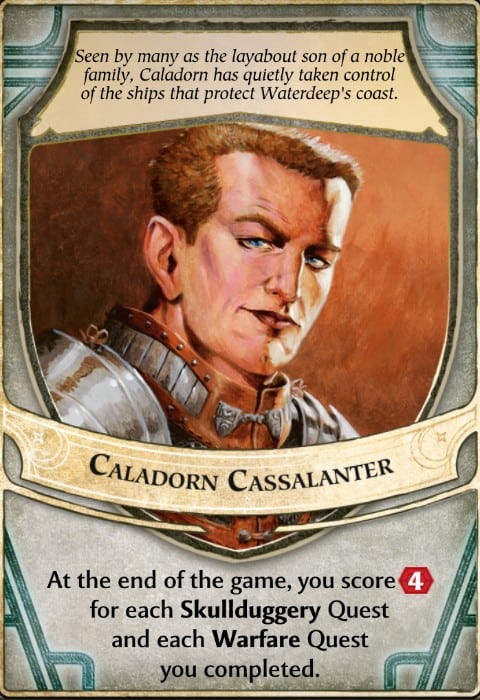
Felica Day’s least favorite lord (seriously, check out the Table Top playthrough of this game, she’s VERY vocal about this) is one that looks like it should work well. It’s two of the “standard” quest types. You can get two rogues in one turn in the base game or two warriors in one turn. With the expansion Slaver’s Market gives you two of each. So this is a great combo, right? Should lead to plenty of victories, right?
WRONG!
Unfortunately there are some basic reasons why Caladorn is going to pose some challenges as a lord. While in theory there are some built in work arounds, he is definitely a C-level lord as he needs some help via plot quests, top-tier Warfare/Skullduggery quests, and/or buildings to really hit the next level of being a danger to other players.
The first problem: Warfare quests need warriors followed by some clerics, wizards, and an occasional rogue. Skullduggery quests need mass rogues, some wizards, and clerics/warriors are very distant 3rd and 4th. That’s pretty poor synergy.
The second problem: Everyone wants the top Warfare quests and plot quests, meaning many will be snatched away from you.
That is a tough 1-2 punch to overcome. You need a fair balance of all types of units, and many Skullduggery quests require money. This means you need every resource and a board that provides that in spades will also provide resources often higher scoring Piety and Arcana quests need, as well.
So how do you overcome these problems? How can you play Caladorn Cassalanter in Lords of Waterdeep and hope to win?
Grab Your Powerful Plot Quests
Plot quests like Seize the Citadel of the Bloody Hand and Bolster Griffon Calvary (if the players understand how good a plot quest this is) should have everyone going after them in the first three rounds. If you get dealt these or can grab them first, you 100% should. In fact Bolster Griffon Calvary should be your number one priority. More free warriors is critical to making Caladorn work.
Also pay attention to Bribe the Shipwrights (Commerce Plot Quest) which will give you badly needed free rogues every time you land on a space that gets you gold. If you have The Lieutenant in round one or two that can be worth going after. This tends to be a bit stronger in 3 player games versus 4 (against logic) and in games where there are buildings with big pay-offs. If the building selection is poor, that plot quest is weaker. If it’s past round three, just ignore it. Your resources are better spent elsewhere.
Fix the Champion’s Games is a very important plot quest for this specific lord. Expand Guild Activities for more rogues can also be important if the available quests seem to be skewing towards Skullduggery instead of Warfare. In most cases don’t go for the plot quests that offer two warriors or two rogues, respectively, every time you grab that type of quest from Cliffwatch Inn.
Criss-Cross Rewards
Look for Skullduggery quests that pay a reward of warriors and Warfare quests that reward rogues. Chain-linking these quests is the best chance to be able to overcome the natural disadvantage of having two quest types that generally ask for wildly different pieces. There are a couple warfare quests that give multiple rogues as a reward, and a couple Skullduggery quests that give warriors as part of the reward.
Getting these quests and criss-crossing them Warfare-Skullduggery-Warfare-Skullduggery allows you to get those quests done faster and with awarded units so you’re not spending precious meeples to get those recruits. This optimizes the bonus points that Lord Caladorn gives you at end game, which is crucial to get the most out of him.
Snipe an Extra 40 Point Quest
If you can snipe a 40 point quest that isn’t Warfare or Skullduggery – that’s strongly recommended. If you’re on a board that has a few buildings offering gold, Commerce should actually be very doable for this lord. The Piety 40 pointer would be harder – but with no need for gold if there are a few extra buildings offering clerics then that might be a viable one, as well.
Snipe Easy Quests Late Game
Because you are always collecting so many varied units there might be times when you have pieces for a Commerce or Piety quest that requires only a few pieces for a high point pay off. Take advantage and sneak a few of these in if you don’t have any major game-changing quests to focus on.
Special Quests to Look Out For
- Defend the Lance Boardroom (Skullduggery) expensive but counts as bonus points and can quickly supply all your wizard and cleric needs
- Bribe the Shipwrights (Commerce Plot Quest) free rogues for picking up gold is a big deal
- Defend the Tower of Light (Piety Plot Quest) in the first three rounds, definitely worth it as this can give steady wizards or clerics so you can focus on warriors and clerics
- Quests that give warriors or rogues as rewards such as Patrol Dock Ward, Save Kidnapped Nobles, Take Over Rival Organization, and Prison Break
- Unleash Crime Spree & Destroy Temple of Selvartan are very easy 10 pt quests but unless you have an overabundance of pieces, ignore the 10 point bonus with each
Any Special Notes
This is a lord heavily reliant on having the right buildings and plot quests come up, and then being lucky enough to be able to get those quests or hit those open building spaces before other players grab it.
Durnan the Wanderer
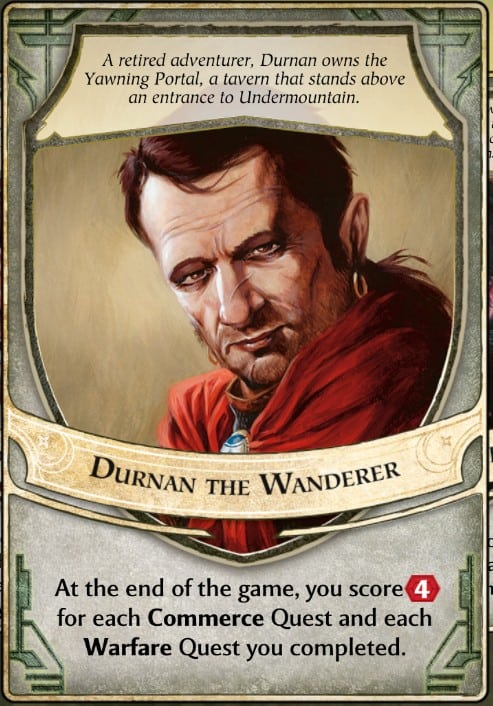
I mean as a vagabond at heart I fully appreciate a name like “Durnan the Wanderer.” That being said, Commerce and Warfare can be a pretty challenging combination. While these two do overlap a bit better than Warfare and Skullduggery, there are some challenges to playing Durnan that you will figure out pretty quickly as a player.
The biggest one is that most people find Commerce to be the most difficult type of quest to make into a powerhouse. For one, the gold costs are by far and away more demanding here than many others. As far as piece demands, it’s a bit of a scattershot. There’s plenty of demand for both warriors and rogues, as well as multiple quests that need clerics and wizards.
This makes it less likely for their to be a choke point for a certain type of piece, but the flip side of that is that you need to hit many different spots to get all the various pieces that you need.
While getting The Lieutenant early can be strong for any lord, it feels even stronger with Durnan because he always needs some more money or another piece. That extra meeple can do a lot of work over seven or eight rounds.
Money, Money, and More Money (GOLD!)
If you’re going to be hitting the Commerce quests hard you need to make sure there is no shortage of gold. Warfare quests tend to consistently demand a little bit of gold but the requirements usually aren’t that bad. There are many Commerce quests that range from five to ten gold. If you have a gold poor board, you’re going to be really hard pressed to get a lot of bonus points from Durnan, which means you need to build a BIG lead from other quests that are popping up on the board.
Can You Build A Warfare Juggernaut?
There is a situation that anyone playing Lords of Waterdeep dreads: seeing the perfect Warfare start when they don’t have a Warfare lord. This tends to be a longshot because it requires a lot of luck and timing to fall into place. However, if you can get Seize Citadel of the Bloody Hand, Bolster Griffon Calvary, and Fix Champion’s Games Plot Quests all finished early, you’re set up to be a monster. Especially if you get any of the strong Warfare quests later on in the game.
If you can purchase Citadel of the Bloody Hand or simply get access to that building most of the time, chances are you can “Game Over” it just focusing mostly on Warfare quests and building up a ridiculous reserve of warriors.
However, anyone who has played realizes just how much of a longshot it is to make all those pieces fall into place. There’s a reason this lord is C tier.
Avoid Overvalued Traps
While following these next tips won’t guarantee victor while playing Durnan the Wanderer, they will help you to avoid obvious traps that tend to cause defeat. One is to avoid plot quests that look good but rarely provide value. Unless you get an unusual array of intrigue cards, or take corruption to fill in the meeples on round one you otherwise would have to grab yourself, avoid the Commerce Plot Quest that gives you 4 gold every time you grab a Commerce quest. It rarely pays off. Especially if you finish it after the first few rounds.
You should also avoid the Warfare Plot Quest that gives you two warriors each time you grab a Warfare quest. Chances are you’ll snap up the far majority of Warfare quests you get for the whole game before you finish this quest. This is doubly true in a four player game. The Lieutenant is valuable but if he shows up in round five or later, he won’t give back enough to make it worth it.
Special Quests to Look Out For
- Fence Goods for the Dark Lord (Skullduggery Plot Quest) gives you much needed gold every time you grab a rogue – and gives you breathing room on a gold poor board
- Again Recover the Magiser’s Orb (Arcane Plot Quest) is a great choice for this lord because it means on a gold poor board you still have options
- Any quests offering gold as an award (multiple Warfare and Arcana do this)
Any Special Notes
Usually the winning strategy with Durnan is to hit the Warfare quests strongly, buy any building that provides a lot of gold for the table (especially if it gives you passive gold as business owner), and look for the Commerce quests that use the same pieces as Warfare quests. This is one of the best ways to try to squeeze the most out of every meeple and not get caught constantly a wizard short or a cleric short.
Mirt the Moneylender
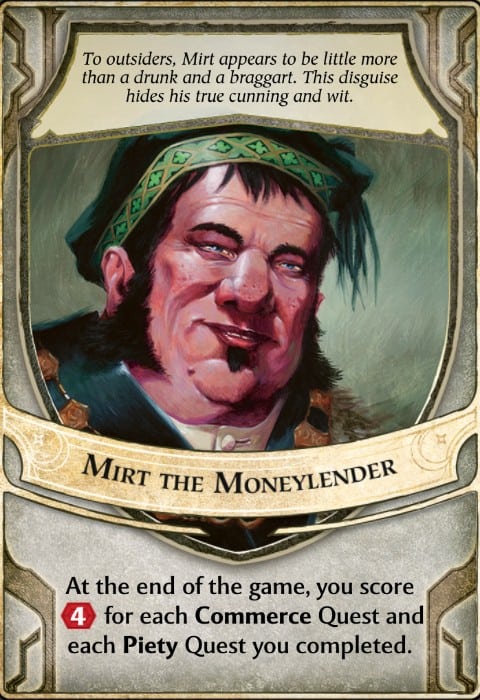
One of Braden’s least favorite lords, there are some good arguments to move him down even further than this, especially on a gold poor board, but there’s enough potential to leap ahead that he remains a C-Tier lord. Though it’s worth noting that in my personal experience playing over 1,000 games of Lords of Waterdeep that Mirt is probably the most volatile of the C-Tier lords.
There are plenty of scenarios where he shoots up the board. There are plenty of others where he drops like a stone. If this is the lord card you drew for your next game you’re certainly in for a ride!
Both Commerce and Piety are high gold quest types. In fact, they tend to be the two highest, which instantly poses a challenge to whoever draws Mirt for their next game. Both tend to use Clerics and Warriors, with some Wizards in the mix. Some Commerce quests require a few rogues here and there, as well.
There is a pretty good synergy between these two quest types however there’s no denying that even on a gold heavy board, players with Mirt often run into major problems producing enough gold to keep on completing quests.
Grab ALL the Gold
So many of the good Piety quests require four gold. That adds up fast. Many of the best Commerce requests require much more. If you’re trying to burn out 15 quests in a game, that gold is going to add up very, very quickly.
Look to buy buildings early that will flood the board with gold. The more, the better. You will also want to look for intrigue cards that allow you to take gold, or non-bonus quests that give gold as an award. Stockpile as much as you can. I’ve had over 30 gold with this lord and ran out a couple rounds later.
This will consistently be the main choke point for playing Mirt the Moneylender in Lords of Waterdeep.
Create a Cleric Pipeline
While not as important as the money flow, this is an important part of playing this lord. Whether purchasing buildings that allow you to pick up extra Clerics, finishing plot quests that allow you to grab extra Clerics, or even taking extra corruption from the open spaces on the board, you will want to give yourself options for creating this piece type. These are mandatory for Piety quests, and many Commerce quests will require one or two Clerics, as well.
If you can secure this + gold early, you’re setting yourself up for success.
Look Outside the Bonus Score
Mirt is a Lord that requires you to think creatively and take opportunities that present themselves. This means looking at plot quests that you might not usually go for, considering playing the Intrigue Card game really hard (especially if your early intrigue cards have you drawing or playing more of them), or looking at what types of pieces are easiest to get and picking up quests that use those pieces.
Four bonus points is nice, but if you can finish 2-4 more large quests instead that might be worth more total points. Do both if you can, but if you can’t, try to weigh the likely number of points between each path. Sometimes you have to go off-road to get the most out of Mirt.
Special Quests to Look Out For
- Fence Goods for the Dark Lord (Skullduggery Plot Quest) the Skullduggery plot quest with a familiar face on it – you’ll need all the gold you can get for this lord and getting free gold for rogues is a very sweet deal
- Any plot quests allowing you to take more Clerics
- Commerce quests that allow you to build buildings for free – because why not hit two birds with one stone?
- Threaten the Builder’s Guild (Commerce Quest) – an expensive but strong quest that is especially good for Mirt…and hopefully you can finish while there are multiple gold and Cleric producing buildings face up in Builder’s Hall
Any Special Notes
You want as many gold producing buildings out on the board as possible. Ideally, you can buy them to get passive income as the owner even when you’re not using them on your turn. If this isn’t possible because of already scarce gold, it’s best to entice others to buy the buildings and then simply use them to re-stock your supplies.
Sammereza Sulphontis
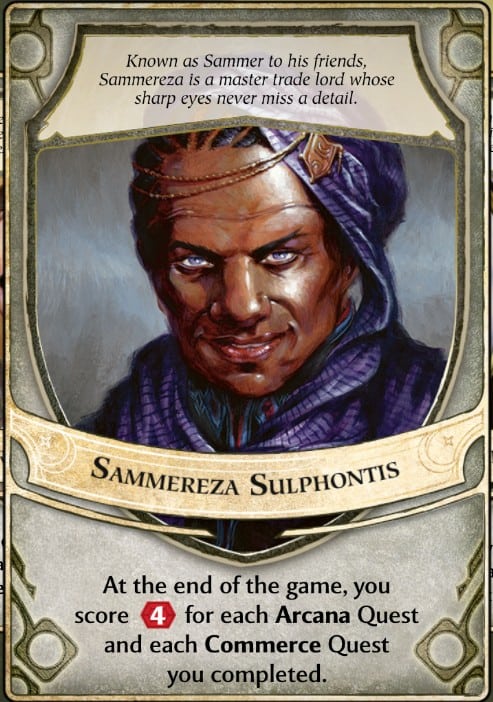
I love the artwork that comes with this lord. In fact, I get excited each time I draw this lord. Then I remember, this is the Arcana lord who never works out. This isn’t so bad that it ends up being a D-Tier lord but it is one of those that seems like it should work way better than it will usually play out.
There are a few reasons for this. The first is that Arcana and Commerce don’t really mesh. Arcana is majority Wizards/Rogues with moderate gold demands while Commerce is very high gold demands with Warriors/Clerics & some Rogue/Wizard needs. In other words, you find yourself generally needing all four types of units on a semi-regular basis.
And gold. Followed by more gold. Followed by even more gold.
Throw in the fact that Arcana has a lot of popular quests (Plot Quests, low piece Quests, etc) and you will find many players deciding to snipe many of the quests that you need for bonuses.
The wide variety of pieces needed along with the constant demand for gold and other players sniping some of your strongest quests can make Sammereza quite a challenge to play effectively.
Aggressively Grab the Quests You Want
Most players get really nervous if they’re in round three or four without any completed quests. Obviously if you have a high priority plot quest you want to get that as quickly as possible – but aggressively grabbing quests is crucial for this lord. In the first four rounds if the decision is between more pieces, a place on Waterdeep Harbor, or grabbing an Arcana, Plot, or Commerce quest you want, you should grab the quest.
Personally I find that a well-done aggressive strategy of sucking up the quests you want early pays off big time and makes giant end of game jumps in points more likely. Doing this also means you’re gathering gold and intrigue cards along the way, which gives you more tools to get resources, use Waterdeep Harbor, or rain down Mandatory Quest hell on your opponents.
Don’t be afraid to clear Cliffwatch Inn if there aren’t any quests that help you or that you want, and don’t let other players getting ahead early throw you off this strategy. Remember that Lords of Waterdeep is a European Style board game. That means you can be down 50, 60, 80 points and then once corruption penalties and bonus points are counted, you leap ahead to victory. We’ve seen it happen more than once.
Look for Wizard Producing Buildings
There are multiple buildings that allow you to pick your piece of choice as well as a couple of major wizard producing buildings. These are crucial pieces for this lord and if you have a chance to get them out, then that is a good play to make. Wizards can be hard to come by, and so if you have the opportunity then you want to get those potential wizard factories out there.
Think long-term when you have intrigue cards that let you grab one or two pieces of your choice. Don’t waste that on that last warrior or rogue you need to complete a quest (unless it’s the last turn). Grab a wizard, and get those more common pieces with your next meeple. In over a thousand games played I can count on two hands the number of times I had an “overabundance” of wizards at the end of the game. It just generally doesn’t happen.
Look at Unconventional Routes for More Gold
There are many intrigue cards that give a choice between gold and pieces. This is the one time where taking four gold is often the right choice over taking a wizard. Look at the board and make the decision. There are Warfare quests and Skullduggery quests that give gold as a reward. Take a look at those. Pay attention to buildings and what perks they offer owners.
Unless High Duke’s Tomb came up on turn one (and if it did you were the one who bought it, right? RIGHT?) gold is going to likely be a scarce commodity. If you’re competing with another player who has a Commerce lord, it’s going to be rough going.
Special Quests to Look Out For
- Bribe the Shipwrights and/or Fence Goods for the Dark Lord. You need gold, you will need rogues here and there, being able to get both as bonuses will give you a fighting chance
- Threaten the Builder’s Guild Commerce Quest
- Seize Citadel of the Bloody Hand (Warfare Plot Quest) – one of the strongest plot quests period, in early game this allows you to take a wizard and use it over and over again, or do the same with that occasional solo cleric you need
- Deal with the Black Viper – it’s a wild card but depending on what four cards you draw, this is devastating. If you have Study at the Librarium, this is a ridiculous monster of a quest
Any Special Notes
If no one else will buy buildings that create gold, you will need to it. On intrigue cards that let you choose between gold and pieces you should go with gold just because it will be such a premium for this lord. Also if you have been building a wizard and rogue pipeline, the gold will be the most important resource left – and most likely choke point.
Many times between Commerce and Arcana quests you will find you have the pieces for an oddball Skullduggery quest. If the points, corruption return, or rewards are worth it then consider taking that chance.
Kyriani Agrivar
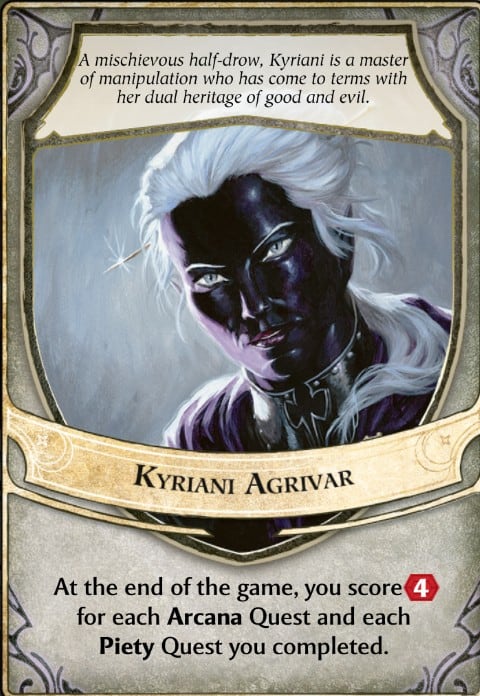
Honestly, I’m a touch surprised this is in the original board game and not an expansion. To some extent it makes sense, but considering that wizards and clerics were the hardest pieces to come by, by not even close, a lord that is set for Piety and Arcana is asking you for all the extremely hard to acquire pieces in large amounts.
That is going to be rough in even the best circumstances. If you get the special expansion buildings that flood the board with clerics, or wizards, or let you choose multiple pieces of whatever you want, then suddenly Kyriani becomes a really strong lord.
In fact, the ONLY reason that Kyriani isn’t in the weakest lords (D grade) section is that if Arcana and Piety quests tend to be higher points and deliver better bonuses for completing. So if you get a steady supply or either clerics or wizards, then this lord gets better. If both appear in abundance, which is rare but does happen every so often, this lord becomes very potentially powerful very quickly.
However, when you’re relying not just on one but multiple buildings to make a lord playable, that’s rough. You also need to be the player who owns the buildings for the passive bonus, or beat everyone else to using the buildings.
That’s before taking into account the fact you’re still competing with other players for some of those major quests.
So how do you play Kyriani?
First of all, getting some early top-notch plot quests and/or “always powerful” quests like Yawning Portal or any of the 40 point quests that pop out. Many times the major points from this lord come from taking advantage of quality quests that are showing regardless of bonus and grabbing them when they are available.
You also need to keep an eye on the Piety and Arcana quests that take relatively few pieces for a lot of points. Those are going to be crucial, and these usually require gold so you want to grab extra gold whenever viable.
Finally, often times the best strategy with Kyriani Agrivar, especially when wizards, clerics, or even gold is at a premium, is to look for quests not requiring gold and the best overall quests on the board. This could be 40 point quests, it could be high point low piece quests in Warfare, Skullduggery, or Commerce. Yes, that means not optimizing for the bonus this lord provides.
But if that bonus has you chasing the scarcest resources all game, then you’re better off going a different direction and just snagging some of the easiest to acquire Piety/Arcana quests as they come up to get a little bit of a bonus at the end of the game. Most Kyriani games I actually won started with me grabbing some of the best warfare plot quests out there that generate more warriors, getting a high score, and just picking up the small Arcana or Piety quests when they were available.
Counter-intuitive: but often the best strategy. If there are buildings that provide a lot of wizards or clerics: grab those buildings, choke off the rest of the board, and then don’t be afraid to hit the reset quests spot on Cliffwatch Inn to make sure you’re making use of them (not to mention increasing your chances of revealing and grabbing a 40 point quest).
Special Quests to Look Out For
- Produce a Miracle for the Masses (Piety Plot Quest) allows you to convert any one piece into a cleric once a round. If you get that round one, that’s 8 free clerics you can create and that’s a game changer for this lord.
- Any plot quest that gives you a boost based on what the board is showing (gold on a gold-starved bored, extra warriors on a warfare quest heavy board, etc)
- Defend the Lance Boardroom (Skullduggery Quest) was built for this lord
- Fence Goods for the Duke of Darkness (Skullduggery Plot Quest) you’ll need gold and this plot quest gives you another way to get a lot of free gold while collecting rogues – which you’ll need for many Arcana quests anyway.
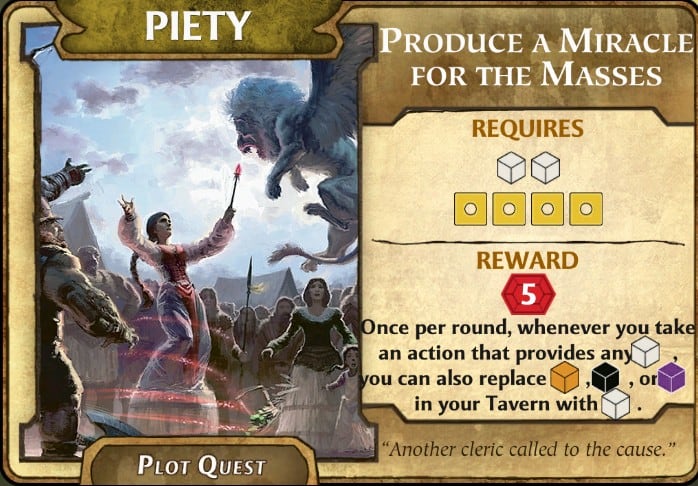
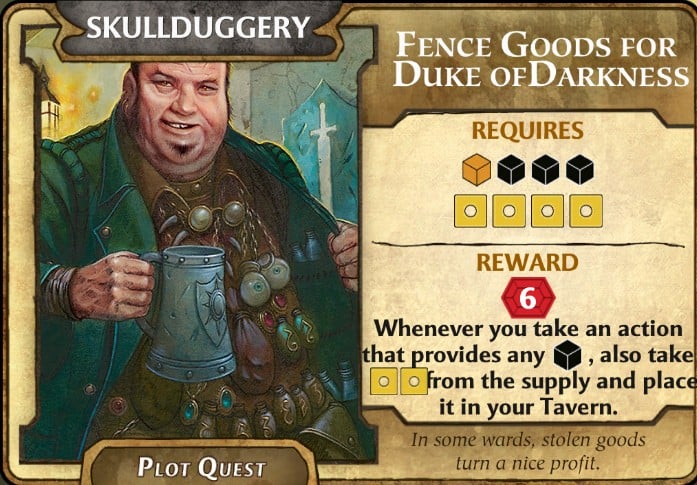
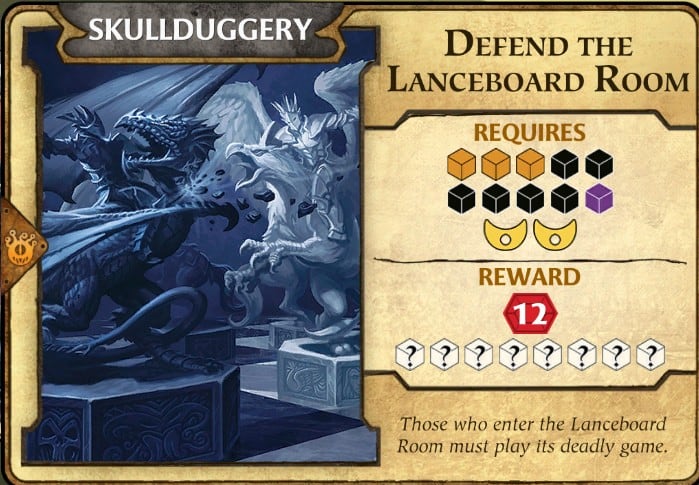
Any Special Notes
Immediately buy any buildings that provide a way to get wizards and clerics. If there are buildings that can toss gold around the board, those are also really good pickups. This lord needs help to compete with the top tier lords, and the benefit of having top notch buildings helps close that gap more than it hurts you.
Playing the Weakest Lords
Some lords just aren’t nearly as strong as others. While that doesn’t mean it’s impossible to win with these lords in your hand, you will almost certainly need good quests, good buildings, and maybe even a little bit of luck to pull it off. A win with one of these lords over an experienced table of players is definitely something to brag about, although sometimes you’ll need to be content with just a good showing.
Playing these lords to their best often requires unusual strategy – and sometimes even tactics that are counter-intuitive.
Playing the A-grade lords is easy, playing these well is what really separates the novices from the really consistently solid players.
Nymara Scheiron
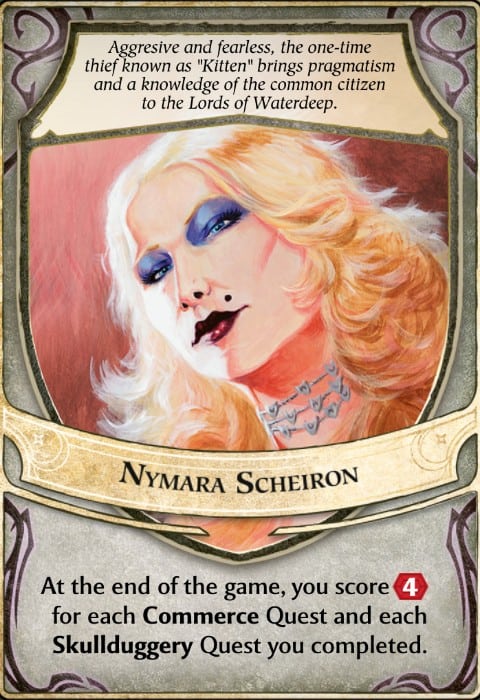
To me Nymara is one of the most vexing of all the lords. Commerce and Skullduggery should go hand in hand. They’re similar in nature, they sound like they go hand in hand, but in gameplay they often end up clashing like honest merchants and the Thieves’ Guild. For a long time this lord frustrated me because it Should work well so why did I struggle?
Then I looked at things a little more in-depth and realized this was the Mimic of Lords. She looks incredibly powerful and set up for success, but without the perfect board or plot quests she’s actually going to poison your chances of winning.
The problems: Commerce quests demand HUGE amounts of money. So do MANY Skullduggery quests. On a cash poor board where anyone else needs to grab gold for their quests, this becomes scarce quickly and that can straight out hamstring you. Gold is always at a premium.
Second, Commerce generally requires gold first, warriors second, clerics third. But Skullduggery generally requires gold first, rogues second, wizards third. That has you scrambling for every resource on the board, including doubling down on gold: an often scarce resource everyone needs to go after.
In other words the demands are high for a successful run with good bonus scoring, in fact it’s some of the most demanding in the game, but without any extra boost to the bonus you get.
So playing Nymara. First off, you absolutely want to find, grab, and complete “Fence Goods for the Dark Lord” and/or “Bribe the Shipwrights” plot quests. These aren’t just bonuses, but when you have both this lord jumps up to actually becoming dangerous when getting rogues give you free money and getting money gives you free rogues.
Second is to be active in the building game. You need a board that has gold on it. If someone else buys these buildings that’s good – but you want to buy them because you want that passive gold from when other people use them. The more gold producing buildings in play, the better for your win chances.

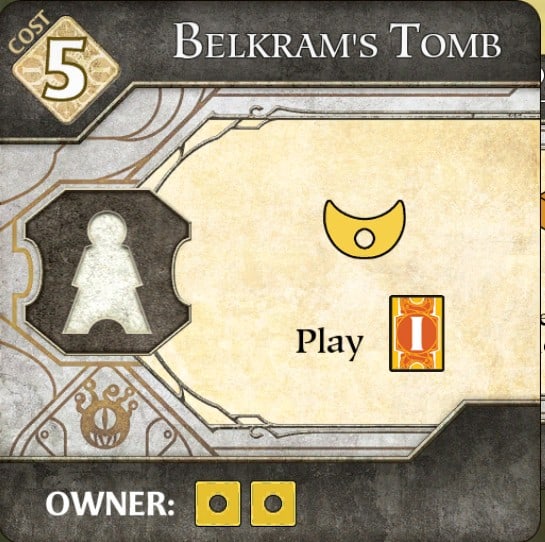
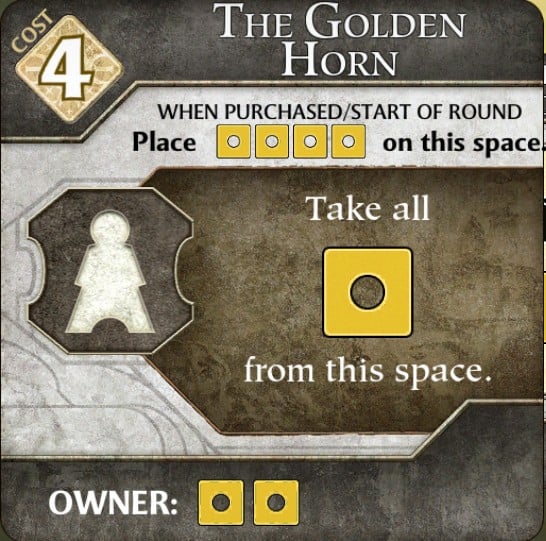

That also means you definitely want to grab the “return corruption,” and “bonus points for building” commerce plot quests if they come up early. If you can get to the point where building a building gets you points and gets rid of corruption in addition to making those resources available, and any combination of money/rogues, then by late mid game this lord can become one of the strongest on the board.
Trouble is that rarely will all these pieces come together and do so early enough in the game to take full advantage. Do what you can with what pieces you can pull together. You may find that you have to focus overwhelmingly on just commerce or just skullduggery. There’s nothing wrong with that.
If you can’t build the ideal board, then play what the board is willing to give you. Don’t be afraid to toss skullduggery quests at Cliffwatch Inn to find more Commerce (or vice-versa) if that’s how the game is playing out. The worst thing to do with this lord is to get pulled in every direction.
Special Quests to Look Out For
- If you can double plot quest “Fence Goods for the Dark Lord” AND get “Bribe the Shipwrights” then you can actually make this lord very powerful.
- “Save Kidnapped Nobles” Skullduggery quest since this eliminates corruption, gets you bonus, AND gives you soldiers to chain into a commerce quest
- “Infiltrate Builder’s Hall” & ‘Defame Rival Business” to supercharge any building efforts
- “Extort Aurora” isn’t ideal, but some extra corruption might be a small price to pay for gold on a cash poor board
Any Special Notes
Finding a way to grab/generate gold resources while getting the most out of every piece is critical to get the most out of his lord. With the right array of early plot quests this lord can actually become one of the strongest in the game…but you’re asking for a LOT of unlikely scenarios to happen.
However, getting just a couple of these strategies going early can keep you in the game long enough to look for that lucky break or all important quest/building to show up.
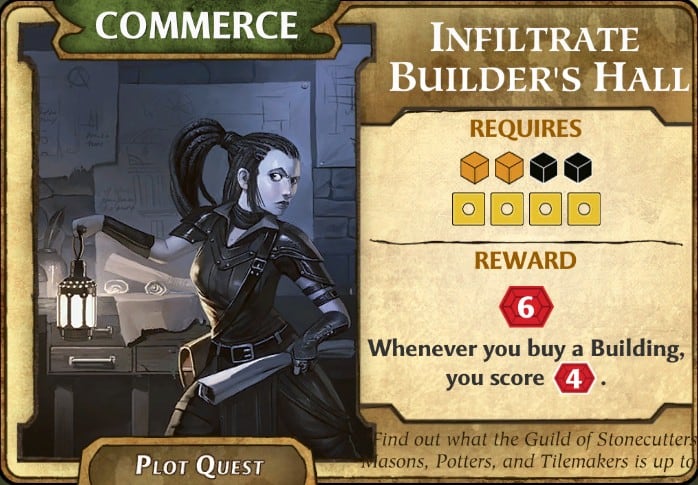
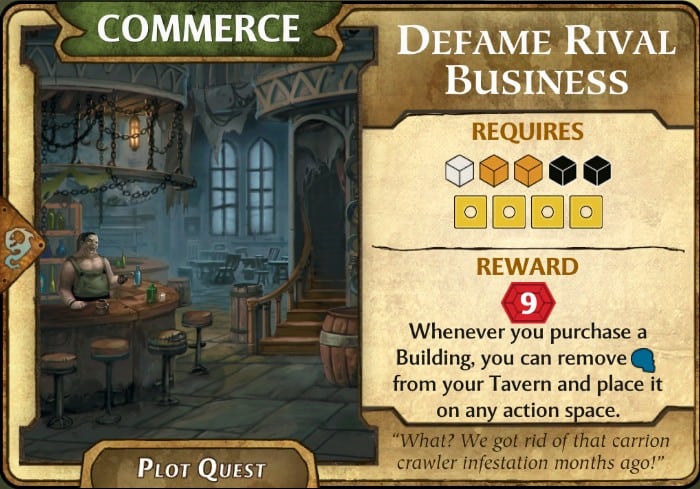
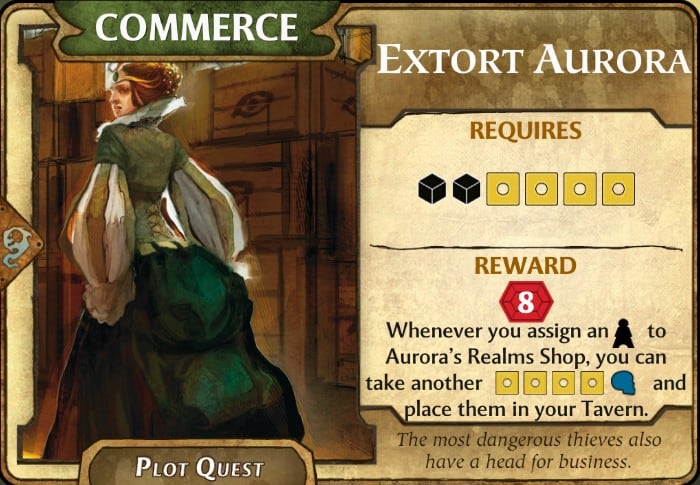
Nindil Jalbuck
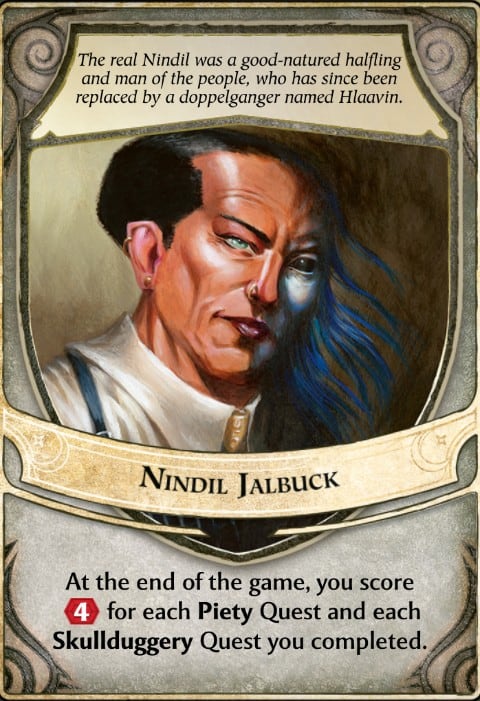
I appreciate the literary reference and the Dr.Jekyl/Mr.Hyde persona but from a mechanic gameplay standpoint ugh is this one a mess. Piety and Skullduggery are two types of quests that generally speaking just don’t mix well. Piety requires a lot of clerics followed by warriors while Skullduggery requires a lot of rogues followed by wizards.
Both require a not insubstantial amount of gold, which can prove very restricting. The one plus side: Piety quests often can help get rid of that corruption that many great Skullduggery quests will require you to take to finish.
Still, this is not a great lord and in my eyes it is straight out one of the weakest. You’re really hoping for the expansion building that floods the board with clerics if you have this lord – or
Most lords with two base types of bonus quests play out so you will usually lean in one direction a little bit more than the other. With this lord this habit is usually exacerbated heavily.
In other words, if you want to successfully play Lord Jalbuck that usually means going extremely heavy Piety or extremely heavy Skullduggery and pretty much ignoring one of your two bonus quest types.
There are some exceptions, but that is what happens most of the time.
Playing this lord well means paying attention to the obvious high quality plot quests and general quests but also seeing if the buildings and available quests are breaking heavily towards Piety or towards Skullduggery, and riding that flow. If a lot of other players seem to be scrambling for one type of quest or the other, it can be worth going with the other group just to avoid fighting for already scarce resources.
If you get several of the Piety quests that reward you with the ability to grab another quest from Cliffwatch Inn definitely take advantage of those. This allows you to use your other meeples to grab resources instead of grabbing another quest.
This is a hard lord to play and getting the quests and buildings below can provide a huge boost to getting to where you need to go.


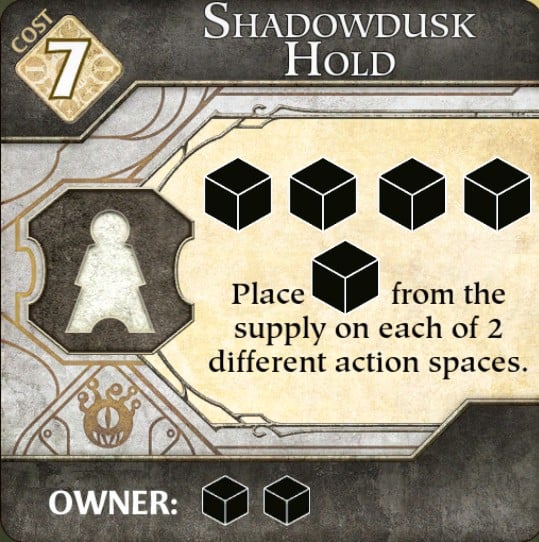
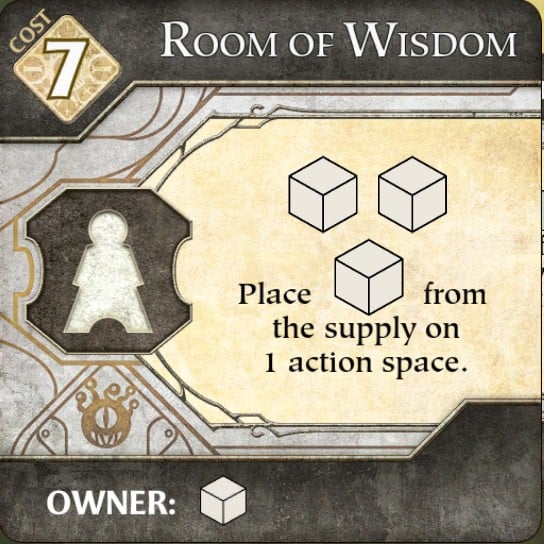
Special Quests to Look Out For
- Bribe the Shipwrights (Commerce Plot Quest) to get extra rogues with your gold or Fence Goods for the Dark Lord (Skullduggery Plot Quest) to get gold when you grab rogues
- Diplomatic Mission to Suzail (Piety Plot Quest) because you need every available meeple focusing on resources you can get
- Any Piety quests allowing you to grab other quests as a reward
Any Special Notes
If you’re using our home rule just choose the other lord? In all seriousness, the heart of this lord is usually getting some of the premium plot quests or general quests that are always considered strong no matter which lord you’re playing. You MUST focus on low resource Piety quests. Playing a heavy intrigue card game is a great way to get cards that give you extra resources, get rid of corruption, or toss mandatory quests to slow down stronger lords.
This Lord’s bonus quests don’t mix well but there will be opportunities to grab a relatively easy to complete quest here and there – and there’s where most of the bonus will come in with this lord.
The Xanathar
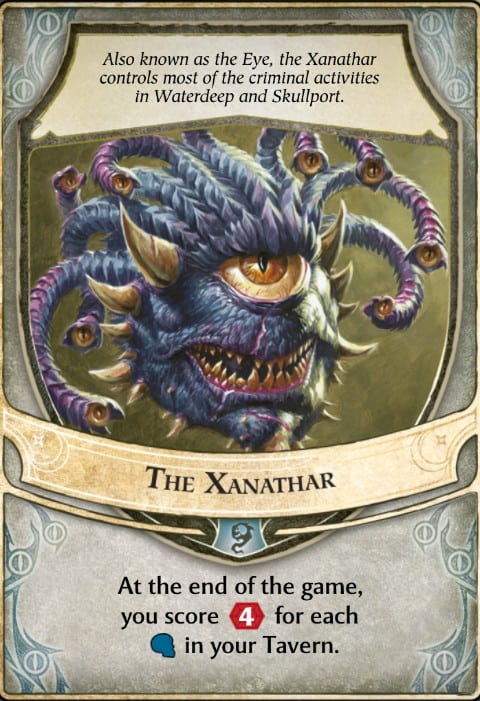
A quick list note on Xanathar: this lord is basically unplayable if you want to compete for a win. Especially against experienced players. He is the only lord that has a “bonus” that almost guarantees you zero points or negative points. Even in an optimal situation where no one else took corruption and no one played cards or buildings that removed corruption from the game, the most bonus points you can get as Xanathar is 8. That’s it. Eight.
Because the point penalty to corruption still applies to all your corruption!
That means your +4 looks like crap if it’s also taking a -8. While this lord can mitigate damage done by corruption, that limit to the actual bonus is killer.
In a long 4 person game top tier lords can manage north of 40 points. In long 3 person games I’ve seen that number swell as high as 60 points.
You just can’t compete with that as Xanathar.
While the idea behind the mechanic is cool, it just doesn’t work. Not in a low corruption use game, and not in a large corruption use game.
It’s just a lot of bad news period.
If you didn’t use our recommended house rules, or are playing a group game online, and end up with The Xanathar…well feel free to try out different strategies, cause chaos, and just enjoy yourself because it’s all about the experience at that point. The ability to actually compete with experienced players just won’t be there.
Remember the Board Matters
Generally speaking when you’re playing with solid players the round figuring out bonuses will really determine who ends up winning. Many a game between us at Assorted Meeples was decided during this phase. In fact, there are very few games when they were not.
No matter what lord you get (other than The Xanathar, in which case you’re screwed), there are certain strategies you should always remember. Just the short list:
- No matter what the lord take top-rated or powerful plot quests available in the very early rounds
- Certain quests like Defend the Yawning Portal are strong no matter what – grab those quests
- Always grab a 40-point quest
- Adapt to the board
Most of the time Wizards and Clerics are hard to come by and gold is a precious resource. But there are odd games out there and you need to adjust accordingly. We’ve had games where a player had 60 gold at end of game and everyone had over 20. There are rare games where Wizards and Clerics abound but Warriors are hard to come by.
When those weird rare games come along you need to adjust accordingly. Playing the board and anticipating where the choke points are going to be lets you adapt your strategy so you can get ahead of the problems just around the corner. Let the other people deal with those.
Follow the advice in this article, adjust based on the board, and you’ll see your win percentage shoot up in no time!
The Extended Tabletop Lords of Waterdeep Featuring Wil Wheaton
They only play the base game, not the awesome expansions, but it’s a very entertaining look at the game, how it’s played, and also features Felicia Day and Pat Rothfuss.
DnD Articles You May Enjoy
- Best Feats for Wizards
- Best Feats for Warlocks
- Best Feats for Rogues
- Sorcerers Vs Wizards 5E
- Barbarians Vs Fighters 5E
Other Board Game Articles You May Enjoy

Proud to embrace the locally created moniker of “Corrupt Overlord” from one of the all time great Lords of Waterdeep runs, Shane is one member of the Assorted Meeples crew and will be hard at work creating awesome content for the website. He is a long-time player of board games, one time semi-professional poker player, and tends to run to the quirky or RPG side of things when it comes to playing video games. He loves tabletop roleplaying systems like Dungeons & Dragons, Pathfinder, Werewolf, Fate, and others, and not only has been a player but has run games as DM for years. You can find his other work in publications like Level Skip or Hobby Lark.
